At the time of writing:
- DBS’ share price have slumped from a high of S$31.28 in early-May 2018 to S$18.93 now – down by 39%
- UOB’s share price have plunged from a high of S$30.37 in end-April 2018 to S$19.73 now – down by 35%
- OCBC’s share price have plummeted from a high of S$13.90 in early-May 2018 to S$8.80 now – down by 37%
Looking at the above statistic, it seems that the 3 Singapore banks achieved their peak at around the same period, and are also suffering a similar magnitude of fall from its high (at the time of writing.)
In this post today, I’d be sharing with you my personal technical analysis of the 3 Singapore banks, along with how their share prices may move in the near-term. I’d also be sharing with you a simple comparison (by taking their current valuations and compare against its 8-year average) to find out whether or not the banks are currently trading at a discount (or not), and finally, I’d also be sharing with you my investing plan for the 3 banks.
Let’s begin.
My Personal Technical Analysis of the 3 Banks
DBS (SGX:D05):
The following is the share price movements of DBS since April 2010, along with the various support/resistance, and uptrend/downtrend lines I’ve identified. The black support/resistance line at S$24.07 is where I’ve invested in the bank:

The last time DBS’ share price was trading at around S$18.93 was back in April 2017. Now, zooming into the bank’s most recent share price movements, especially since the beginning of March, there was a huge selldown (I’ve highlighted it in a black rectangular box in the chart below). Also, if you look at the trading volume in the same time period (I’ve highlighted this in a red rectangular box below), the trading volume was much higher than usual during those few days, suggesting that the bears are very much in control of the share price movements:
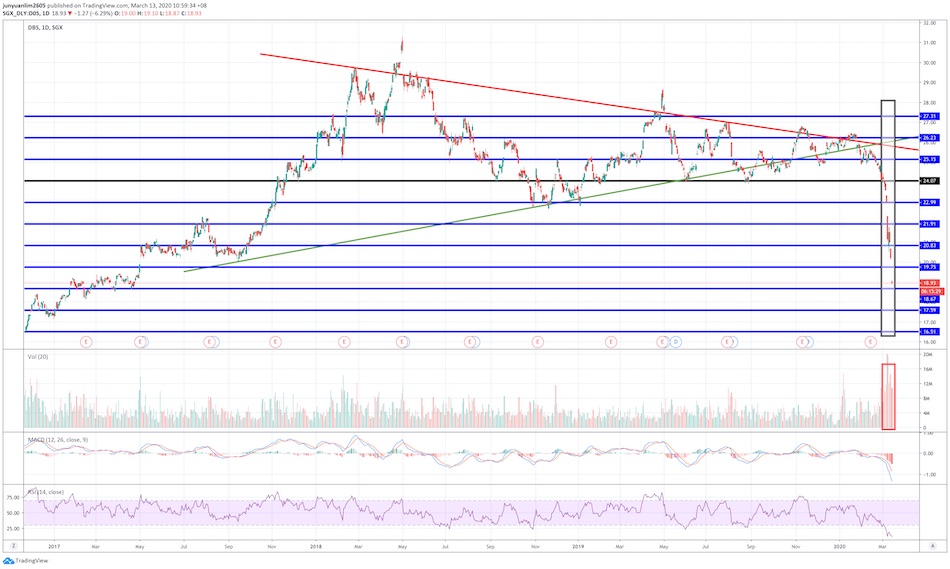
Looking at today’s share price movement (at the time of writing), it is inching towards the support line at S$18.67. Should this support line be broken at a high trading volume, then it is likely that the share price of DBS may slip further down to the next support lines at S$17.59 and S$16.51 in the near-term.
As to whether the share price of DBS will continue to fall below S$16.51, I have no idea at this point in time. I will continue to monitor the share price movements and will provide another update should the share price plunges below the support line at S$16.51.
UOB (SGX:U11):
The following chart is UOB’s share price movements since April 2010, along with the various support/resistance lines, and uptrend/downtrend lines I’ve identified. The black support/resistance line at S$23.27 is the price I invested in the bank:
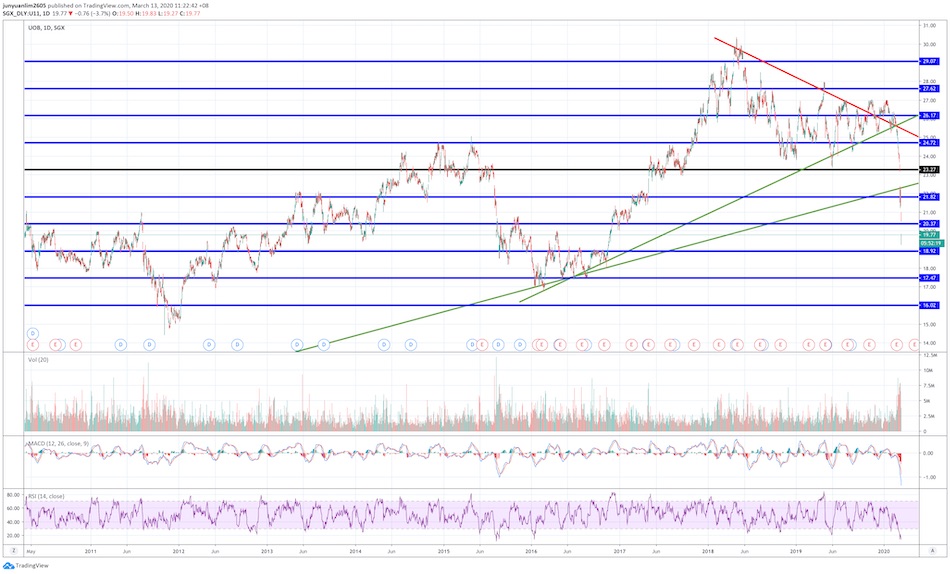
The last time UOB traded at around S$19.73 was in November 2016. Similar to DBS, UOB’s share price started to plunge since the beginning of March (I’ve highlighted the share price movements in a black rectangular box in the chart below). Also, notice the trading volume for the same time period (highlighted in a red rectangular box below) – they were way above the normal trading volume as well, suggesting that the bearish selldown of the bank’s shares is a strong one:
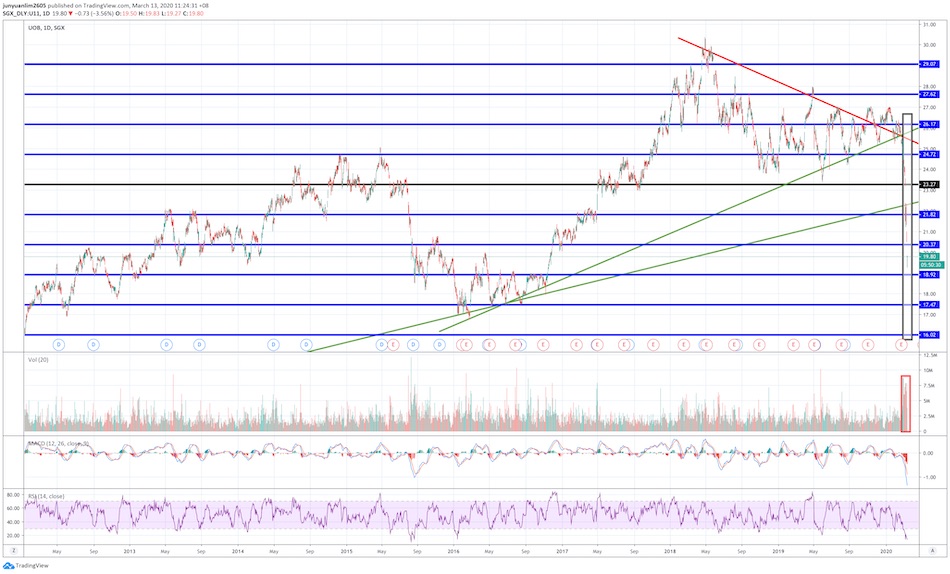
At the time of writing, the immediate support line is at S$18.92. Should the share price break below this support line on a high trading volume, then in the near-term, the share price could further slide to the next support level at S$17.47, and then to S$16.02 (should the bearish run continues.)
I will provide another update on the bank’s share price movements should the share price were to slip under the S$16.02 support line.
OCBC (SGX:O32):
The following is the share price movements of OCBC since April 2010, along with the various support/resistance lines, and uptrend/downtrend lines which I’ve identified. The black support/resistance line at S$10.50 is the price I’ve invested in the bank:
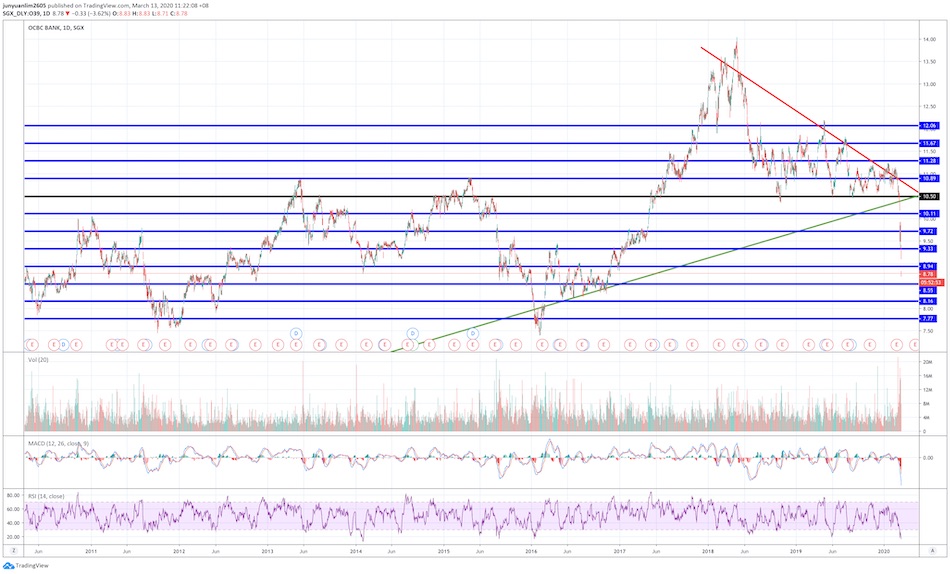
OCBC’s share price movements suffered from the same fate as DBS and UOB, where its share price came crashing down since the beginning of March (I’ve highlighted its share price movements in a black rectangular box below.) Also, the trading volume for the same time period is also higher than normal (I’ve highlighted the trading volume in a red rectangular box below), suggesting that the bears are also in full control of the share price movements of OCBC at this point of time:
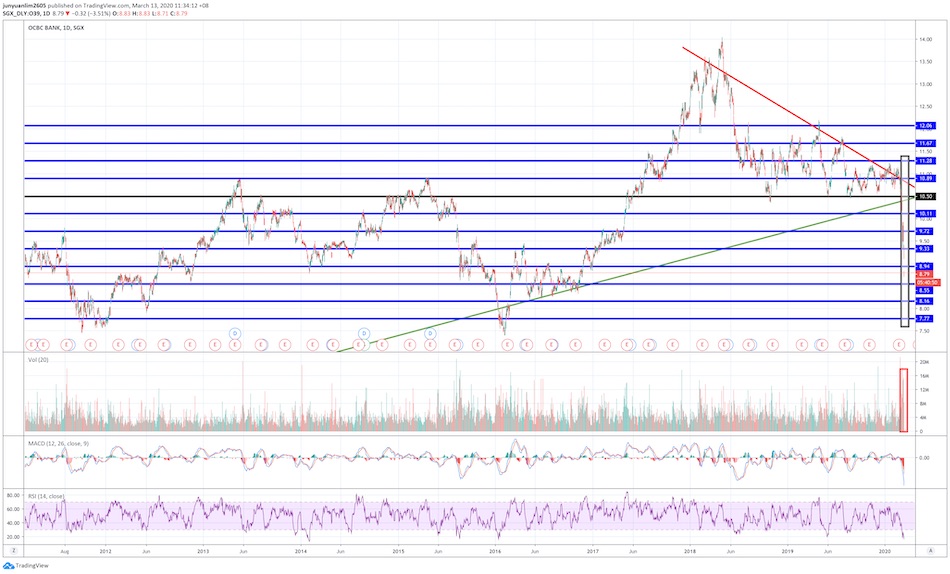
At the time of writing, OCBC’s share price is heading towards the support line at S$8.55 Should the share price were to continue to drop below this support line at a high trading volume, then it is likely that the share price of the bank may be headed to the next support lines at S$8.16, and S$7.77.
As to whether the share price of OCBC will further plunge below S$7.77 support line, I do not have an answer at this point in time. However, I will provide another update on the bank’s possible share price movements should that happen.
Based on their Historical Valuations, are the 3 Banks Considered Cheap Now?
The following are the 3 banks’ current valuations based on their share prices at the time of writing, along with their 8-year average valuations which I’ve computed, to help you better see if the 3 banks are currently trading at a discount (or not):
DBS:
The following are the current and 8-year historical average valuations of DBS:
| Current Valuations | 8-Year Average Valuations | |
| P/E Ratio | 7.7 | 11.2 |
| P/B Ratio | 1.0 | 1.2 |
| Dividend Yield | 7.0% | 4.1% |
UOB:
The following are the current and 8-year historical average valuations of UOB:
| Current Valuations | 8-Year Average Valuations | |
| P/E Ratio | 7.6 | 11.4 |
| P/B Ratio | 0.9 | 1.2 |
| Dividend Yield | 6.6% | 4.0% |
OCBC:
The following are the current and 8-year historical average valuations of OCBC:
| Current Valuations | 8-Year Average Valuations | |
| P/E Ratio | 7.9 | 10.7 |
| P/B Ratio | 0.8 | 1.2 |
| Dividend Yield | 6.0% | 3.8% |
Conclusion:
Based on the current and 8-year historical average valuations, the 3 banks are all currently trading at a discount now – due to their lower-than-average current P/E and P/B ratios, along with a higher-than-average current dividend yield.
My Personal Thoughts
As I am investing in the 3 banks (DBS, UOB, and OCBC) for the long-term, I am not bothered by the huge decline in their share prices, for I know that they will recover as soon as the Covid-19 situation around the world comes under control, and it’s business as usual for everyone once again.
In case some of you are wondering if I will be averaging down (it’s another question I get asked lately), my answer is yes, I will seriously consider averaging down should their share prices come down by 50% or more – meaning to say that I will consider averaging down DBS at S$12.00 (50% off S$24.00), UOB at S$11.63 (50% off S$23.26), and OCBC at S$5.25 (50% off S$10.50.)
Having said all of that, the above is my personal investing plan just to share with you for informational purposes only. Please do your own due diligence before you make any investment decisions.
Disclaimer: At the time of writing, I am a shareholder of DBS Group Holdings, United Overseas Bank, and Overseas-Chinese Banking Corporation Limited.
Are You Worried about Not Having Enough Money for Retirement?
You're not alone. According to the OCBC Financial Wellness Index, only 62% of people in their 20s and 56% of people in their 30s are confident that they will have enough money to retire.
But there is still time to take action. One way to ensure that you have a comfortable retirement is to invest in real estate investment trusts (REITs).
In 'Building Your REIT-irement Portfolio' which I've authored, you will learn everything you need to know to build a successful REIT investment portfolio, including a list of 9 things to look at to determine whether a REIT is worthy of your investment, 1 simple method to help you maximise your returns from your REIT investment, 4 signs of 'red flags' to look out for and what you can do as a shareholder, and more!

You can find out more about the book, and grab your copy (ebook or physical book) here...


Comments (14)